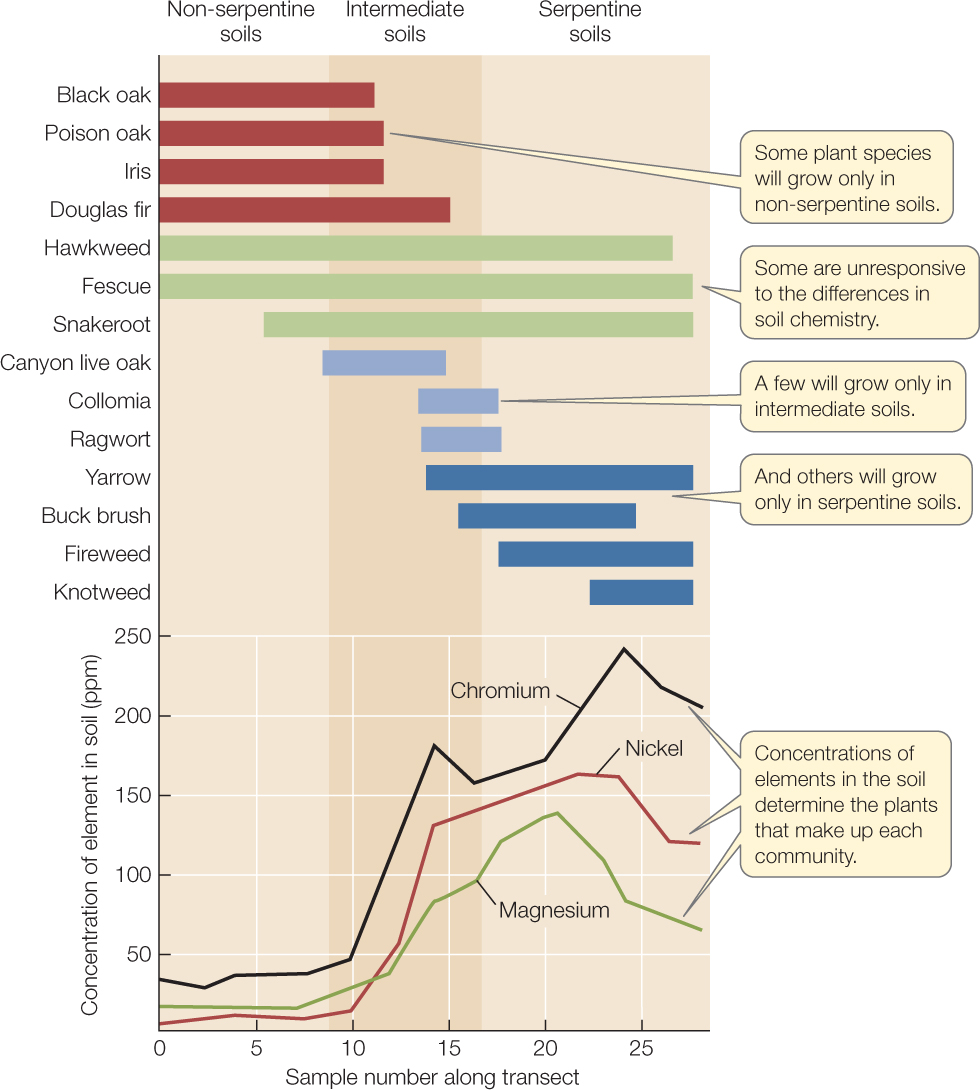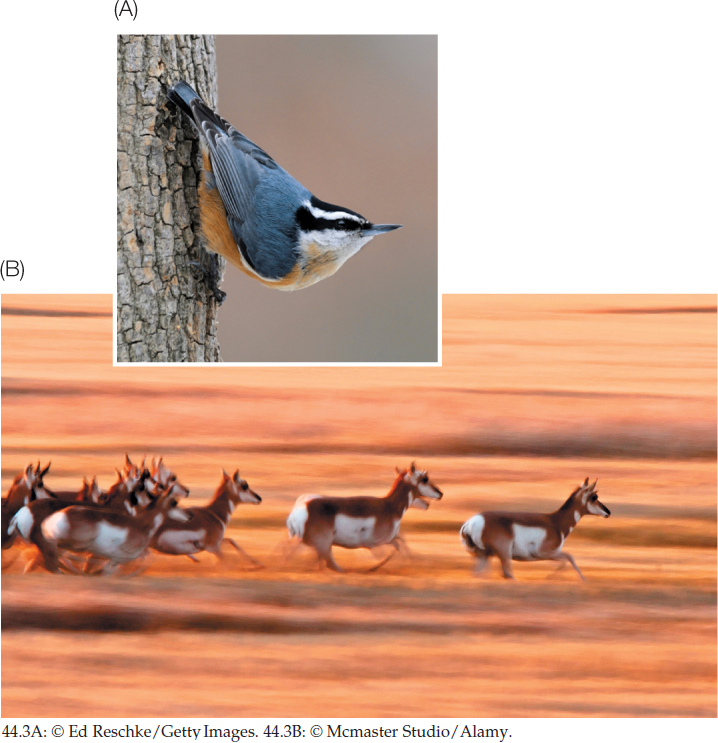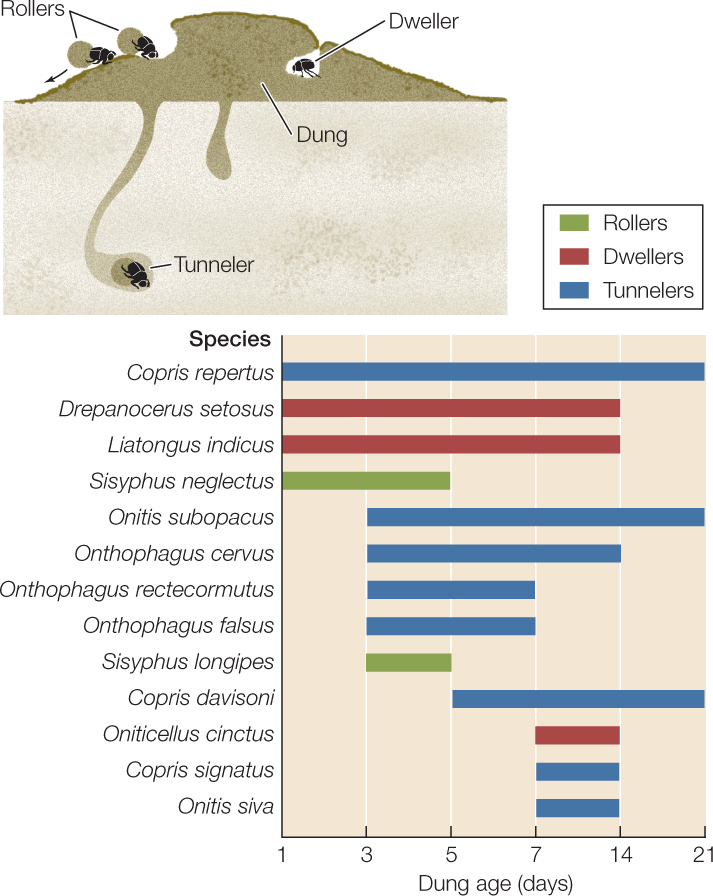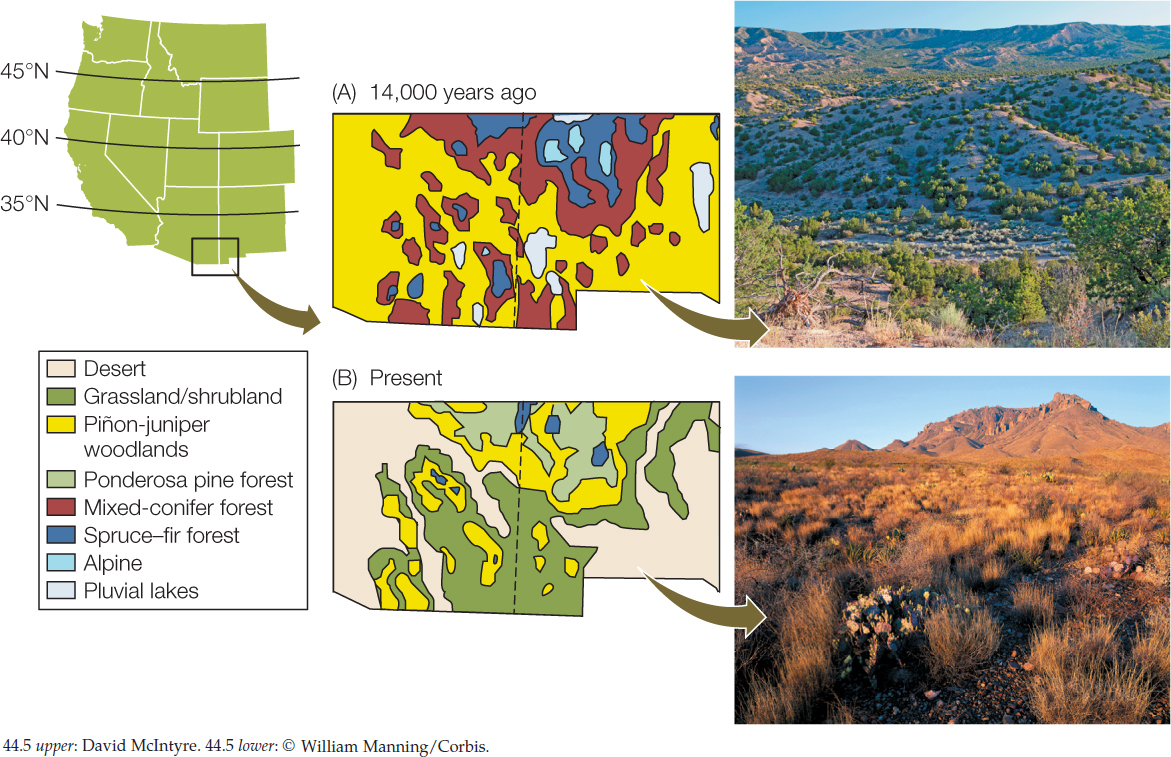Concept 44.2: Communities Change over Space and Time
Ecologists have noted repeated patterns of spatial and temporal change, or turnover, in species composition. These patterns demonstrate that the species we find in one place and time are not a random subset of those that potentially could be there. Let’s take a closer look at these patterns and what they mean.
Species composition varies along environmental gradients
We saw in Chapter 41 that physical conditions on Earth change over long distances—consider how temperature changes with latitude, or pressure with ocean depth. Physical conditions can also change on small spatial scales (see Concept 41.1). If we climb a steep tropical mountain, for example, we traverse gradients in temperature and moisture, and because different species have different tolerance limits, we encounter constantly changing plant communities. In coffee-growing regions, we would find coffee plantations between about 1,300 and 1,500 meters in elevation, where coffee grows best—reflecting its evolutionary origin in African highlands.
Ecologists have characterized how plant communities change along environmental gradients on Krakatau. Environments there range from shoreline habitat that is buffeted by wind and waves to inland habitat that varies in elevation from sea level to 800 meters at the highest point, and from gentle ash-covered slopes to steep rocky cliffs. The composition of Krakatau’s plant communities is similar in locations with similar conditions and different in locations with different conditions. These spatial changes are easy to see from afar because the species in different habitats tend to look different (compare Figure 44.1A,B), just as vegetation in the tropical rainforest biome differs from vegetation in tropical savanna (see Concept 41.3). Sandy beaches are dominated by low-growing herbs and vines, bordered inland by a fringe of short trees and shrubs; gentle inland slopes are dominated by taller trees with an understory of vines and ferns, and the summit, often in the clouds, supports a thick growth of short, moss-covered trees.
Spatial turnover in the species composition of communities often signals hard-to-see gradients. The rock outcrops that provide habitat for Edith’s checkerspot butterfly near San Francisco (see Figure 42.1), for example, contain soils derived from serpentine rock, which is unusually high in heavy metals such as chromium and nickel. If we measure off a transect—a straight line used for ecological surveys—running from a non-serpentine to a serpentine area and identify the plants that occur in evenly spaced samples along it, we will find that several species drop out and new ones appear partway along the transect, where heavy-metal concentrations jump (FIGURE 44.2).

The early naturalist–explorers who documented associations of climate and vegetation—the biomes described in Concept 41.3—likewise documented associations of particular animal species with particular vegetation. Some animal species, such as Edith’s checkerspot butterfly, are found in certain plant communities because the plants they eat grow there. In other cases, animals are associated with particular plant communities because plants modify physical conditions such as temperature and humidity and because plants contribute to habitat structure: the horizontal and vertical distribution of objects in the habitat. The vertical distribution of leaves and the density, size, and surface texture of plant stems influence which species are present by determining the effectiveness of their methods for obtaining food, avoiding predators, building nests, and so on. Morphological, physiological, and behavioral traits of animals adapt them for the structure of the habitats with which they are associated (FIGURE 44.3).

Several processes cause communities to change over time
Species composition changes not only over space, but also over time. Krakatau is not unique in this regard—all communities, not just those in the early stages of assembly, are dynamic. Over longer periods, of course, the species composition of communities reflects evolution. But species turnover also occurs over much shorter periods. Three major processes contribute to this dynamism: extinction and colonization, disturbance, and climate change.
Extinction and Colonization
Ecological communities are likely to change even in a constant environment because species may go locally extinct and be replaced by new species that arrive from time to time. As we saw in Concept 44.1, there are several reasons why a species may go locally extinct. Dispersal is an ongoing process that delivers a constant influx of new individuals to all but the most isolated locations. When individuals arrive at a location that already contains a population of their species, they add to its size (and genetic diversity); when those individuals are members of a new species, they can establish a new population and add another species to the community.
901
Disturbance
An event that causes sudden environmental changes—referred to as a disturbance—can change the species composition of a community. Examples of such events are volcanic eruptions, wildfires, hurricanes, landslides, and human activities. Such disturbances can wipe out some or all of the species in communities and alter the physical environment. Sudden change can also occur without the destruction of a resident community. New environments can appear, for example, when a glacier melts away, a depression fills with rainwater—or a large mammal deposits dung.
After a sudden change in the environment, species often replace one another in a relatively predictable sequence called succession. A fresh pile of elephant dung, for example, is colonized by a predictable sequence of dung beetle species (family Scarabidae). These animals feed on the dung and lay their eggs in it. Some species typically arrive early and are then replaced by later arrivals (FIGURE 44.4).


Go to MEDIA CLIP 44.1 Dung Beetles
PoL2e.com/mc44.1
Several factors are responsible for successional sequence. One key factor is variation in the colonizing ability of species. The first species to arrive in newly available habitat are good dispersers. The early-arriving dung beetles tend to be strong fliers with excellent senses of smell, or are “hitchhikers” that ride on dung-producing animals and colonize dung as it is produced. Similarly, the first plant species on Krakatau were those with seeds that are readily dispersed by water or wind. A second factor is that environmental conditions in the disturbed site change over time. Early-arriving dung beetles must cope with wet conditions, whereas late-arriving species face a drier environment; pioneering species on Krakatau had to tolerate full sun and volcanic ash. Later-arriving species experience an environment that has changed not only because of physical processes, but also because of the activities of early-arriving species. The seeds of plants that colonized Krakatau after the forest canopy had closed had to germinate in the shade of other plants and compete successfully for water and nutrients in soils that earlier colonists had modified.
902

Go to ANIMATED TUTORIAL 44.1 Succession after Glacial Retreat
PoL2e.com/at44.1
When a disturbance damages or destroys a preexisting community, succession often leads in the end to a community that resembles the original one. On Krakatau, the tropical forests destroyed by the volcanic eruption eventually came back. Ecologists now realize, however, that a return to something like the original community is far from guaranteed. Instead, some disturbances may push the system past a threshold, or tipping point, so that there is an abrupt ecological transition to a distinctly different community. The system may then stay in this alternative state and not return to its original state, even when the factor that caused the disturbance is removed. For example, intensive cattle grazing led to an abrupt conversion of grasslands to shrublands in the U.S.–Mexico Borderlands (see the opening story of Chapter 41). Grasslands have not returned, even in places where cattle have been removed.
903
Climate Change
A final cause of temporal variation in communities is climate change. As physical conditions change, the geographic ranges of species necessarily change with them. One way in which ecologists have been able to reconstruct the history of such changes is by analyzing fossilized remains of plants found in middens—refuse piles—left by packrats (Neotoma spp.). These rodents bring plant material into their nests. When the material is preserved, it provides a record of the vegetation that was present when the animals were alive. By using carbon-14 (see Figure 18.1) to date packrat-midden fossils, biologists have been able to show how plant communities of the U.S.–Mexico Borderlands changed over the last 14,000 years as the climate became drier following the end of the last ice age (FIGURE 44.5).

CHECKpoint CONCEPT 44.2
- Why are animal species often associated with particular plant communities?
- How does succession differ from species turnover that results from ongoing colonization and extinction?
- Give an example of an environmental gradient that you have observed yourself, explaining what factors change along it and what visible changes you see in the species present.
We saw in Concept 44.1 that species composition, species number, and species abundances all are aspects of community structure. How do these attributes affect the way a community functions?